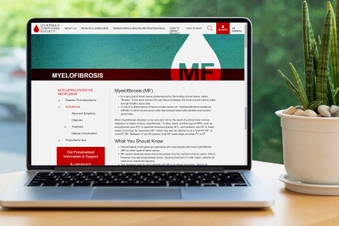Be Your Best Advocate with Myelofibrosis

A Challenging Condition
Myelofibrosis is a rare cancer that impacts your body’s ability to make healthy blood cells. It’s part of a group of diseases called myeloproliferative neoplasms (MPNs). Usually, symptoms come on very slowly over time. But pain and fatigue can eventually make it hard to do everyday activities. Symptoms can vary widely, and there’s no single treatment that works best for everyone. So it’s important for you to take an active role in managing your care.

Educate Yourself
If you’ve just been diagnosed with myelofibrosis, you may feel confused and overwhelmed. You can start to take control by learning all you can about the disease, the different treatment options, and what you can expect as time goes on. Ask your doctor for reputable sources of information. Some places to look online include the Leukemia & Lymphoma Society (LLS) and the MPN Research Foundation.

Find a Specialist
With myelofibrosis, you’ll want to see a doctor who specializes in blood disorders called a hematologist. You can get a referral from your regular doctor or your insurance company, or check with cancer centers in your area. Depending on where you live, you may need to look somewhere else to find someone with experience treating myelofibrosis. There are tools online to help you find a specialist, including one from the American Society of Hematology.

Track Your Symptoms
Myelofibrosis can progress very slowly, and your care team will need to watch carefully for signs that it’s time to start or change treatment. That can mean a lot of appointments and tests. You can help by keeping close track of your symptoms. Write down how you’re feeling day to day. Note anything that’s new, how often you feel it, and how bad it is. The Leukemia & Lymphoma Society has a symptom diary you can download from its website.

Prepare for Appointments
Your time with your doctor will be limited, so it’s important to be prepared. Write down questions as you think of them, then make a list in order of importance in case you don’t have time to get to everything. Bring your symptom diary and a list of all medicines and supplements you take. Call to find out if there’s anything specific you need to do before the appointment, like fasting.

During Your Appointments
To get the best care, you'll need to work well with your doctor. You should be open and honest with them, and listen closely to what they tell you. Take notes during your appointment, or consider bringing a friend or family member to be a second set of ears. If you don’t understand something, speak up. Ask your doctor to repeat the information or explain it differently.

Understand Your Options
Myelofibrosis treatment is very individualized, based on your symptoms, test results, and overall health. Your doctor considers many different things in deciding whether a particular treatment might work for you. But it isn’t all black and white, and your opinion matters. Let them know which symptoms bother you most and how you see your future. If you don’t agree with their recommendation, say so. And feel free to get a second opinion.

Communicating With Your Health Team
You don’t have to wait for your next appointment to get a question answered or report a change in your symptoms. Find a go-to person on your health care team you feel comfortable with who can give you guidance. Keep speaking out if you don’t think you’re being heard, or if your concerns aren’t being addressed. Sometimes a particular doctor just isn’t a good fit. Don’t hesitate to look for someone else.

Follow Through
It’s up to you to stay on top of your care and follow through on your treatment plan. Get your test results and keep a copy of your health records. Know when you’re due for checkups and tests. Take any medication exactly as prescribed and stick to any other advice your doctor gives you. Contact them if you have questions, you notice a change in your symptoms, or you feel like your treatment isn’t working.

Know Your Rights
By federal law, your doctor has to give you your medical records and keep them private. Your state may have other protections. The American Medical Association recognizes other patient rights, such as to be treated with dignity, to be given enough information to make your own decisions, and to have those decisions respected. You may be entitled to certain work accommodations if myelofibrosis makes it hard to do your job.

Get Support
With myelofibrosis, you may just not feel well a lot of the time. It’s important to guard your health, whether that means canceling social plans or asking for help with household chores. Don’t feel like a burden – people who care about you want to be helpful. Be specific about what you need, like picking up groceries or folding the laundry.

Take Care of Yourself
Besides following your treatment plan, looking after your overall health can help you manage your symptoms and keep your energy up when you have myelofibrosis. Get enough sleep, eat a healthy diet, and stay hydrated. Exercise may seem hard if you’re fighting fatigue, but it does help. Find ways to reduce stress, like yoga or meditation.

Get Involved
Connect with a myelofibrosis support community, either in person or online. You can learn a lot from others with the disease. And you can help fight it by working on a fundraiser or education campaign. Doctors are learning more about the disease all the time. You can help, and also get access to cutting-edge treatment, by taking part in a clinical trial. Ask your doctor or search ClinicalTrials.gov for studies in your area.
Show Sources
IMAGES PROVIDED BY:
1. Ida Wyman / Medical Images
2. Moment / Getty Images
3. Moment / Getty Images
4. The Image Bank / Getty Images
5. Vetta / Getty Images
6. DigitalVision / Getty Images
7. iStock / Getty Images Plus / Getty Images
8. DigitalVision / Getty Images
9. Moment / Getty Images
10. Stone / Getty Images
11. DigitalVision / Getty Images
12. DigitalVision / Getty Images
13. E+ / Getty Images
SOURCES:
Leukemia & Lymphoma Society: “Myelofibrosis,” “Choosing A Blood Cancer Specialist,” “Communicating With Your Specialist,” “Getting a Second Opinion,” “Support Resources.”
Mayo Clinic: “Myelofibrosis.”
MPN Research Foundation: “Primary Myelofibrosis (MF),” “Just Diagnosed,” “Find a Hematologist,” “Find Support,” “Clinical Trial Finder.”
American Society of Hematology: “Find a Hematologist.”
CancerCare.org: “Coping With Myelofibrosis,” “When to Get a Second Opinion,” “Understanding Workplace Issues and Cancer.”
U.S. Department of Health and Human Services: “Take Charge of Your Health Care.”
Johns Hopkins Medicine: “Don’t Be Shy: 4 Tips for Talking to Your Doctor.”
MedlinePlus: “Patient Rights.”
American Medical Association Code of Medical Ethics: “Patient Rights.”
Cancer Support Community: “Myelofibrosis.”
ClinicalTrials.gov.